As October rolls in, Halloween enthusiasts around the world prepare for a night of spooky and exciting activities. While countries like the United States have their own share of ghostly tales and spooky traditions, Thailand offers a unique and eerie perspective of the world of spirits that provides an exceptional opportunity to learn Thai and explore Thailand.
Some Thai Language schools, like Duke Language School, for example, celebrate Halloween with fun and creativity.
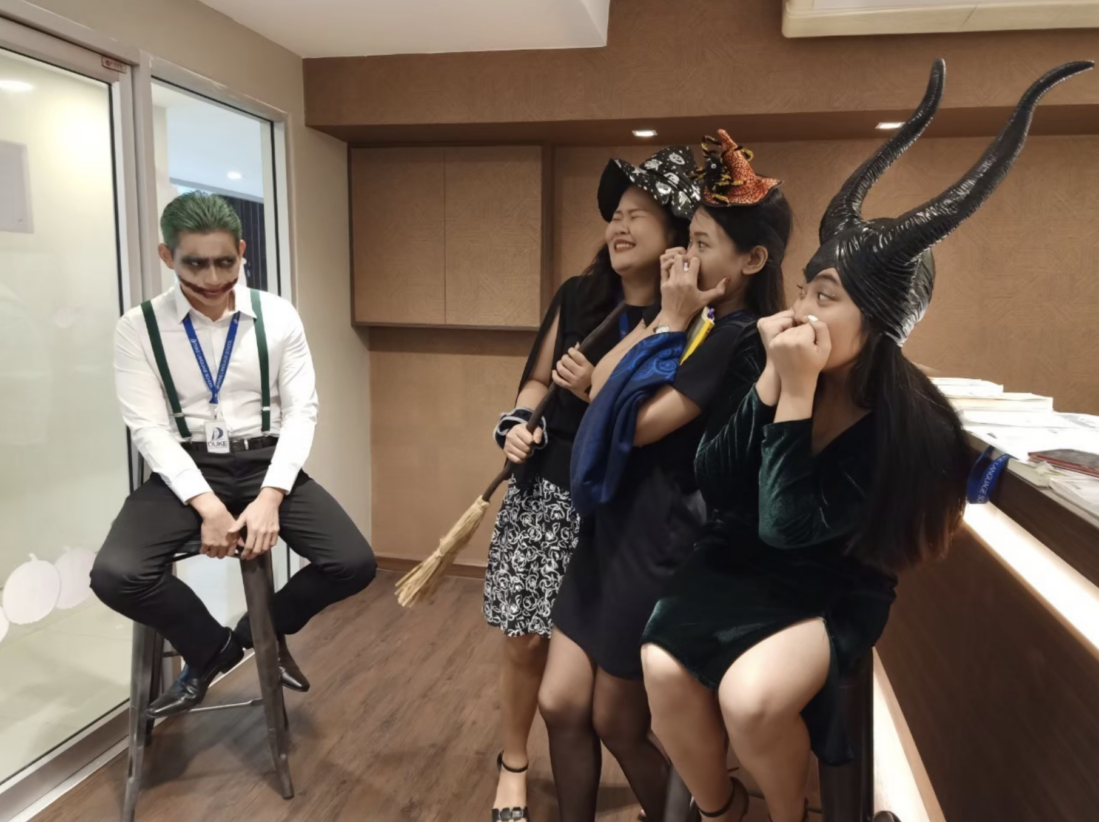
Thai Ghosts: A Tapestry of Fear
Thailand is renowned for its stunning landscapes, rich culture, and delicious cuisine. But did you know that Thailand is equally celebrated for its captivating folklore and ghost stories? Thai ghosts, locally known as ผี (pǐi) have their roots in indigenous beliefs, Hinduism, and Buddhism, resulting in a diverse array of supernatural entities that both terrify and intrigue.

Learn Thai and Discover Thai Ghost Folklore
While exploring the spooky world of Thai ghosts, seize the opportunity to learn Thai by familiarizing yourself with the local terminology used to describe these spectral beings. Understanding terms like ผี (pǐi) will enable you to better explore Thailand’s supernatural realm.
Learning Thai can give you a deeper understanding of Thai culture and folklore, including the beliefs about Thai ghosts. Here are a few ways that learning Thai can help you learn more about Thai ghosts:
Read Thai ghost stories and legends. There are many Thai ghost stories and legends that have been written down and published. Reading these stories in Thai can help you to better understand the Thai perspective on ghosts and the supernatural. If you would like to practice your Thai reading skills, you can get this book: “เรื่องผีๆรอบโลก ผีไทย.” It translates to “Ghost Stories Around The World – Thai Ghosts”. You can find it in the SE-ED book store.
Watch Thai ghost movies and TV shows. Thai ghost movies and TV shows are very popular in Thailand. They can be a great way to learn more about Thai culture. Many Thai ghost movies and TV shows are based on real-life Thai ghost stories and legends.
Talk to Thai people about ghosts. Thai people are generally very open about their beliefs in ghosts and the supernatural. Talking to Thai people about ghosts can be a great way to learn more about their personal experiences and beliefs.
If you are ever in Thailand and you witness a ghost festival or traditional ceremony taking place, it is important to be respectful of Thai customs and etiquette. Here are a few tips:
Be respectful of offerings. Do not step over offerings that have been placed for ghosts. You should also avoid touching or eating offerings without permission.
Do not talk about ghosts in a disrespectful way. Thai people believe that ghosts are powerful and should be respected. Avoid making jokes about ghosts or speaking about them in a negative way.
Let’s have a look at some famous ghosts in Thailand below.
1. ผีปอบ (Pǐi Bpɔ̀ɔp)
Perhaps one of the most infamous Thai ghosts, ผีปอบ (pǐi bpɔ̀ɔp) is often portrayed as a malevolent female ghost that devours the insides of humans and animals. Crossing paths with ผีปอบ (pǐi bpɔ̀ɔp) is believed to bring misfortune or calamity.

https://www.fapot.or.th/main/cinema/view/614
In Thai, the word “ปอบ” is also used to refer to a type of parasite that infests the body. This may be the origin of the belief in ผีปอบ, as it is believed that the parasite can take control of the host’s body and mind.
2. ผีกระหัง (Pǐi Gràhǎng)
This malevolent male spirit, with a reputation for causing harm and chaos, particularly during the night, is a chilling presence that lurks in the dark, creating an unsettling atmosphere.

https://shock.mthai.com/inter-shock/2041.html
It manifests itself as a shirtless man, who flies in the night. ผีกระหัง (pǐi gràhǎng) uses two large กระด้ง (gràdông) – round rice winnowing baskets, to fly in the night in rural areas of Thailand.
3. นางตานี (Naang Dtaanii)
Linked to banana trees, นางตานี (naang dtaanii) is a female spirit tasked with guarding these trees.
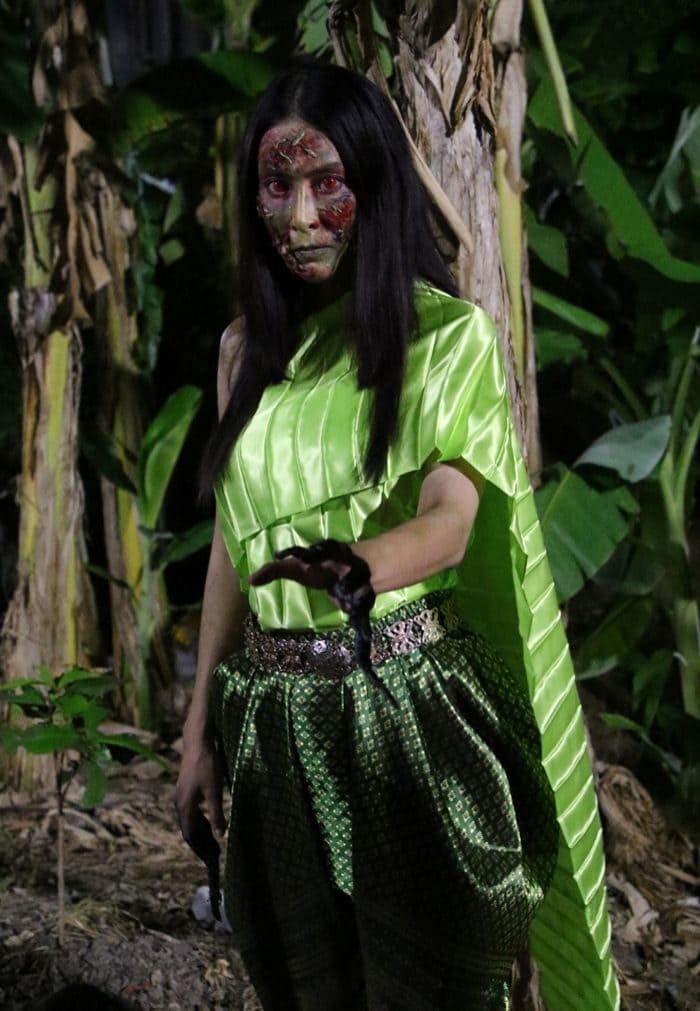
https://promotions.co.th/สำรวจตลาด/fashion-สำรวจตลาด/halloween-dress-up-thai-ghost.html
It is said disturbing her inflicts dire consequences. This is a cautionary tale deeply ingrained in Thai folklore.
4. ผีกระสือ (Pǐi Gràsʉ̌ʉ)
A horrifying Thai ghost, ผีกระสือ (pǐi gràsʉ̌ʉ) is often depicted as a female figure with her head and internal organs detached from her body.
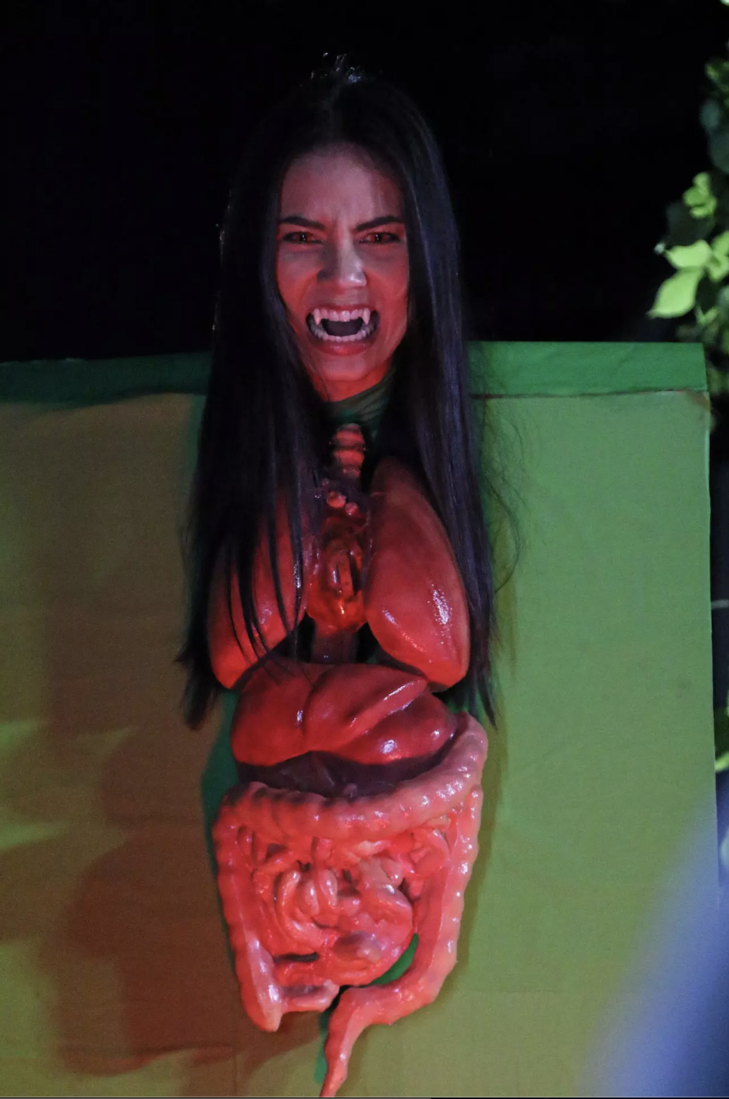
https://www.thairath.co.th/entertain/news/1388752
The head and internal organs of this ghost are said to glow in the dark. ผีกระสือ (pǐi gràsʉ̌ʉ) uses them to hunt for food. Legends suggest that she was a woman who practiced dark magic during her lifetime.
5. ผีอำ (Pǐi Am)
A spirit that sits on a person’s chest during the night. ผีอำ (pǐi am) is thought to be responsible for inducing sleep paralysis.
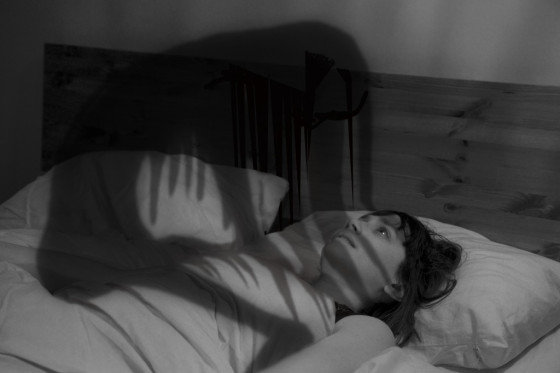
https://pantip.com/topic/37497183
This spirit is primarily associated with the occurrence of distressing nightmares.
6. เปรต (Bprèet)
เปรต (bprèet) is the spirit of a person who has died and has not yet been reborn. They are often depicted as being grotesque and deformed, with large stomachs and tiny mouths. They are also said to be constantly hungry and thirsty, but they are unable to find food or water that can satisfy them.
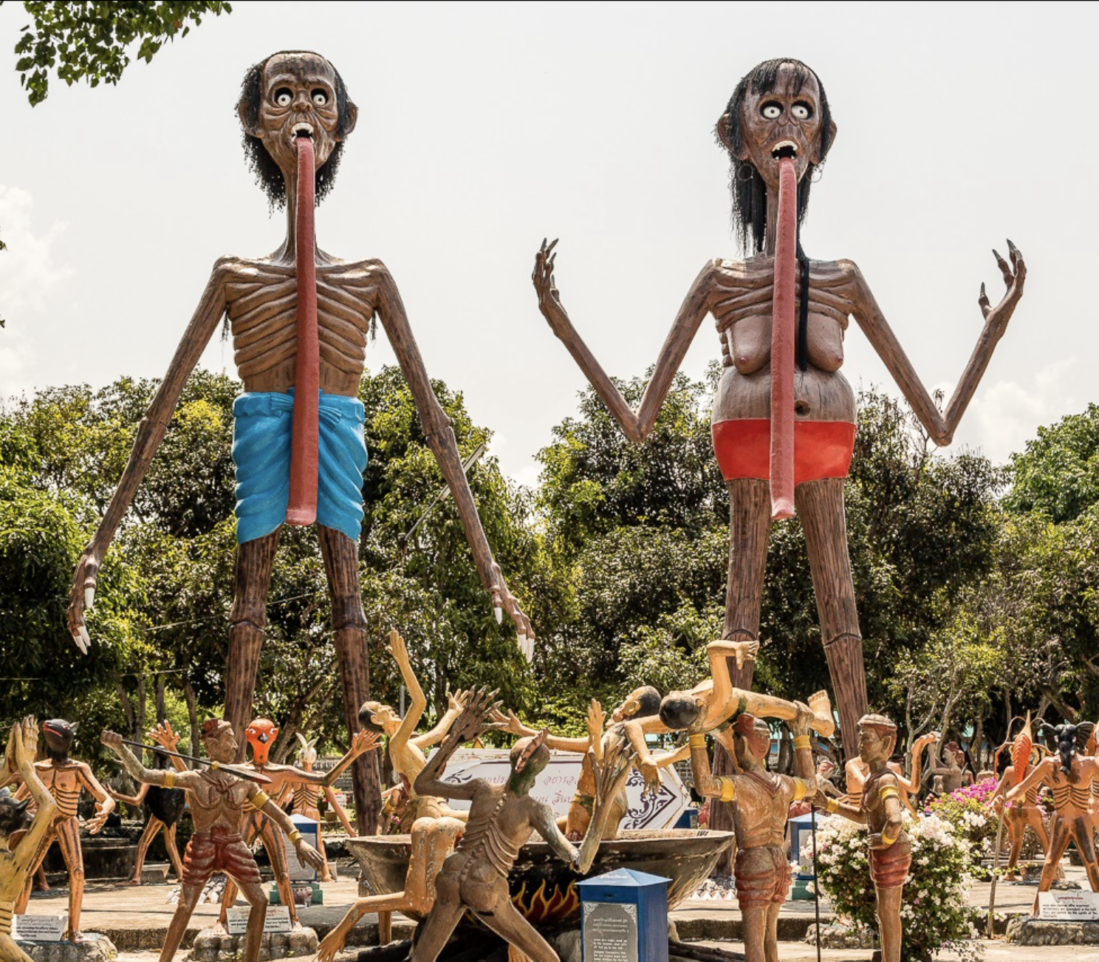
https://hawkebackpacking.com/thailand_wang_saen_suk.html
เปรต (bprèet) are believed to be the result of bad karma in a previous life. They may have been greedy, selfish, or cruel. As a result, they are condemned to suffer in the afterlife.
Beliefs and Superstitions
Thai beliefs surrounding ghosts are closely intertwined with animism, ancestor worship, and Buddhism. The concept of “merit” (บุญ / bun) is central, as it is believed that one’s deeds in life influence their destiny in the afterlife. The annual Ghost Festival, known as ผีตาโขน (pǐi dtaa kǒon) in the northeastern region, involves making offerings to placate restless spirits.
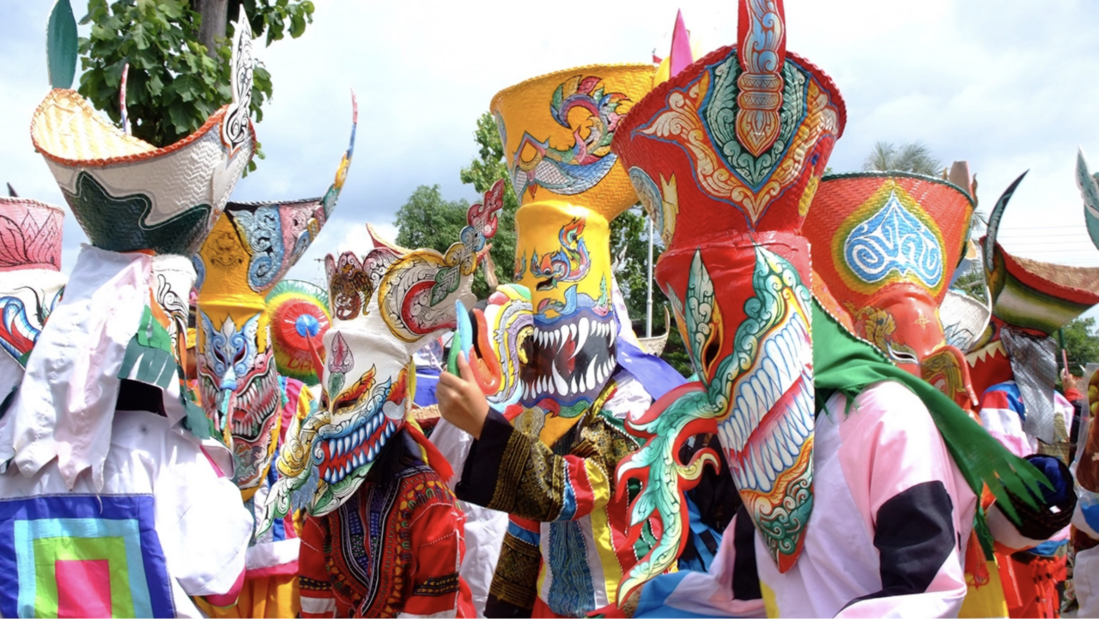
https://www.thairath.co.th/news/local/bangkok/2702361
Dive into the unique culture of spirit houses known as ศาลพระภูมิ (sǎan prá puum) as you explore Thailand.

https://masii.co.th/blog/5-ลักษณะบ้าน-จน
These small shrines serve as dwellings for spirits, and offerings are made to ensure their goodwill and protection.
Haunted Locations
Thailand boasts numerous haunted sites and spine-tingling stories that have been passed down through generations. The แม่นาค (Mɛ̂ɛ Nâak) Shrine in Bangkok, dedicated to the ghost of Mae Nak, a woman who died in childbirth and returned as a vengeful spirit, is among the most famous. This eerie site attracts both believers and thrill-seekers.
As you explore Thailand, be prepared to hear tales of haunted buildings, cemeteries, and forests. Locals often advise against visiting these places after dark, as it is believed that spirits become more active during nighttime hours.
Modern Interpretations
Modern interpretations of Thai ghosts are diverse and reflect the changing social and cultural landscape of Thailand. Thai ghost stories continue to be popular because they offer a way to explore universal themes such as love, loss, and grief, as well as to connect with Thai culture and tradition.
Ghosts as a reflection of social and political issues – In recent years, there has been a trend of Thai ghost films and stories that use the supernatural to explore social and political issues such as poverty, inequality, and gender violence. For example, the film “The Medium” (2021) uses the story of a shaman who is possessed by a malevolent spirit to explore the themes of mental illness and classism.
Ghosts as a way to explore the human condition – Thai ghost stories have also been used to explore universal themes such as love, loss, and grief. The film “Nang Nak” (1999) is a modern retelling of a classic Thai ghost story about a woman who dies in childbirth and returns to haunt her husband. The film explores the themes of love, loss, and the power of grief.
Ghosts as symbols of trauma – In some modern Thai ghost stories, ghosts are seen as symbols of trauma. The film “Shutter” (2004) tells the story of a couple who are haunted by the ghost of a woman who was killed in a car accident. The ghost is seen as a symbol of the couple’s own trauma and guilt.
Ghosts as symbols of social injustice – In some other modern Thai ghost stories, ghosts are seen as symbols of social injustice. “The Promise” (2007) is a film about a ghost who is seeking revenge for being wronged in life. The ghost is seen as a symbol of the oppressed and the marginalized.
Ghosts as a way to explore the supernatural – Of course, some modern Thai ghost stories simply want to be scary and entertaining. These stories often explore the supernatural and the unknown. A film titled “Pee Mak” (2013) is a comedy horror film about a group of friends who are haunted by a ghost. The film is full of jump scares and special effects.
No matter what their interpretation, Thai ghost stories continue to be a popular and important part of Thai culture. They offer a way to explore universal themes, connect with the past, and be entertained.
Conclusion
This Halloween, consider celebrating the holiday in a novel and spine-chilling way by immersing yourself in the world of Thai ghosts. As you explore Thailand and begin to understand the local terminology, you’ll find yourself immersed in a captivating and hair-raising adventure that promises to make your Halloween unforgettable. Thai ghosts add a layer of mystery and intrigue to the rich tapestry of Thai culture, making these ghosts the perfect choice for those seeking an alternative way to celebrate the season of frights and delights.
สุขสันต์วันฮาโลวีน
Sùksǎn Wan Haaloowiin
Happy Halloween!
Loy Krathong – Embracing Tradition and Crafting Krathongs with Duke Language School
Loy Krathong, also known as the festival of lights, is one of Thailand’s most enchanting and culturally rich celebrations. This ancient festival, which typically takes place in November, holds a special place in the hearts of the Thai people. It’s a time to express gratitude, pay homage to the water goddess, and symbolically release worries and troubles into flowing rivers and waterways. At the heart of this festival lies the art of crafting krathongs, intricately decorated floats that carry offerings and wishes. In this article, we will delve into the significance of Loy Krathong and take you through the steps of making your own krathong, while also exploring the unique opportunity to learn Thai at Duke Language School.
The Significance of Loy Krathong
Deep historical and cultural roots: Loy Krathong’s origins can be traced back to the Sukhothai Kingdom in the 13th century, when the festival was first celebrated as a way to express gratitude to the water goddess, Phra Mae Khongkha. Over the centuries, it has evolved, incorporating elements from Buddhist and Hindu traditions.
Celebrating nature: Loy Krathong is a festival that celebrates the importance of water in Thai culture. Thailand, often referred to as the “land of a thousand smiles,” might also be called the “land of a thousand waters” due to its numerous rivers, canals, and lakes. Water plays a crucial role in Thai agriculture and daily life, and Loy Krathong is a way to honor this life-giving element.
Releasing troubles and negativity: Central to the festival is the practice of releasing negative emotions, troubles, and bad luck into the water. As people set their krathongs afloat, they do so with the belief that their worries will be carried away by the currents, allowing them to start anew with a clean slate.
Making wishes: As krathongs gently float away, people often make wishes for the future. These wishes can be personal hopes and dreams or broader aspirations for the well-being of their communities and the world at large. Making a wish while releasing a krathong is a symbolic gesture of hope and optimism.
Expressing gratitude: Loy Krathong is a time to express gratitude to ancestors, teachers, and loved ones. Many people include small tokens or mementos on their krathongs as a way of honoring those who have passed away or played significant roles in their lives.
Crafting Your Own Krathong – 5 Easy Steps
Now that we’ve explored the significance of Loy Krathong, let’s delve into the art of crafting your very own krathong. Creating a krathong is a creative and fulfilling experience, allowing you to immerse yourself in the festival’s traditions.
Step 1 – Gather your materials
To create a beautiful krathong, you’ll need the following materials:
Step 2 – Prepare the base
If you’re using styrofoam or a banana tree trunk as your base, begin by cutting it into a circular shape. Ensure that it’s sturdy enough to hold your decorations and float on the water. The size of your krathong can vary, but it typically measures around 20-30 centimeters in diameter.
Step 3 – Create the decorative layers
Banana leaf base – Cut the banana leaves into small, square pieces. Dip them in water to make them more pliable to prevent them from cracking. Arrange these pieces on the base to form a circular layer, securing them with pins or string.
Decorate with flowers – Place colorful flowers on top of the banana leaf base. Popular choices include chrysanthemums, marigolds, and lotus petals. Use pins to secure the flowers in place.
Step 4 – Add incense and a candle
Insert three incense sticks evenly around the center of the krathong. These sticks symbolize the elements of earth, water, and fire. Place a candle in the middle, making sure it’s secure. You may need a small piece of banana leaf or wax to hold the candle in place.
Step 5 – Final touches
Attach a small coin – It is customary to attach a small coin or money offering to your krathong as a symbol of gratitude and respect for the water goddess. Use string or pins to secure it to the krathong.
Trim and shape – Use scissors and a small knife to trim any excess banana leaves and shape your krathong. Ensure that it’s well-balanced and can float steadily on the water.
Learn Thai
While Loy Krathong offers a glimpse into the rich culture and traditions of Thailand, one can further immerse themselves in Thai culture by learning the Thai language.
Here are some pictures from Duke Language School’s Loy Krathong activity from previous years.
Duke Language School offers a variety of Thai language courses for learners of all levels, from beginners to advanced speakers. Our Thai language instructors provide comprehensive language instruction that covers speaking, listening, reading, and writing skills. Whether you’re a traveler looking to communicate more effectively during your visit to Thailand, or someone interested in deepening your understanding of the culture, learning Thai at Duke Language School can be a rewarding experience.
By enrolling in a Thai language course, you can enhance your appreciation of Loy Krathong and other Thai traditions. Speaking the language not only allows you to communicate with locals more effectively but also enables you to connect on a deeper level with the culture and heritage of Thailand.
Conclusion
Loy Krathong, the festival of lights, is a cherished Thai tradition that allows Thai people to connect with their cultural heritage, express gratitude, and release their worries into the water. During this holiday, people craft krathongs. Krathongs are beautiful, handmade floating objects that carry offerings and wishes. By following the five steps outlined in this article, you can create your own krathong and participate in this beautiful celebration. As you release your krathong into the water and make your wishes, take a moment to take in the atmosphere, the flickering candlelight, and the reflections on the water’s surface. Loy Krathong is not only a time for celebration but also a time for reflection, gratitude, and cultural enrichment.
When you study Thai with us at Duke Language School, you will deepen your understanding of Thailand’s culture and language, enabling you to more fully connect to Thailand and its people. As Loy Krathong approaches, remember that this festival offers not only the beauty of lights on the water but also the opportunity to explore the richness of Thai culture through language and tradition.
สุขสันต์วันลอยกระทง
Sùksǎn wan lɔɔi gratong
Happy Loy Krathong!
Halloween and Ghosts in Thailand
As October rolls in, Halloween enthusiasts around the world prepare for a night of spooky and exciting activities. While countries like the United States have their own share of ghostly tales and spooky traditions, Thailand offers a unique and eerie perspective of the world of spirits that provides an exceptional opportunity to learn Thai and explore Thailand.
Some Thai Language schools, like Duke Language School, for example, celebrate Halloween with fun and creativity.
Thai Ghosts: A Tapestry of Fear
Thailand is renowned for its stunning landscapes, rich culture, and delicious cuisine. But did you know that Thailand is equally celebrated for its captivating folklore and ghost stories? Thai ghosts, locally known as ผี (pǐi) have their roots in indigenous beliefs, Hinduism, and Buddhism, resulting in a diverse array of supernatural entities that both terrify and intrigue.
Learn Thai and Discover Thai Ghost Folklore
While exploring the spooky world of Thai ghosts, seize the opportunity to learn Thai by familiarizing yourself with the local terminology used to describe these spectral beings. Understanding terms like ผี (pǐi) will enable you to better explore Thailand’s supernatural realm.
Learning Thai can give you a deeper understanding of Thai culture and folklore, including the beliefs about Thai ghosts. Here are a few ways that learning Thai can help you learn more about Thai ghosts:
Read Thai ghost stories and legends. There are many Thai ghost stories and legends that have been written down and published. Reading these stories in Thai can help you to better understand the Thai perspective on ghosts and the supernatural. If you would like to practice your Thai reading skills, you can get this book: “เรื่องผีๆรอบโลก ผีไทย.” It translates to “Ghost Stories Around The World – Thai Ghosts”. You can find it in the SE-ED book store.
Watch Thai ghost movies and TV shows. Thai ghost movies and TV shows are very popular in Thailand. They can be a great way to learn more about Thai culture. Many Thai ghost movies and TV shows are based on real-life Thai ghost stories and legends.
Talk to Thai people about ghosts. Thai people are generally very open about their beliefs in ghosts and the supernatural. Talking to Thai people about ghosts can be a great way to learn more about their personal experiences and beliefs.
If you are ever in Thailand and you witness a ghost festival or traditional ceremony taking place, it is important to be respectful of Thai customs and etiquette. Here are a few tips:
Be respectful of offerings. Do not step over offerings that have been placed for ghosts. You should also avoid touching or eating offerings without permission.
Do not talk about ghosts in a disrespectful way. Thai people believe that ghosts are powerful and should be respected. Avoid making jokes about ghosts or speaking about them in a negative way.
Let’s have a look at some famous ghosts in Thailand below.
1. ผีปอบ (Pǐi Bpɔ̀ɔp)
Perhaps one of the most infamous Thai ghosts, ผีปอบ (pǐi bpɔ̀ɔp) is often portrayed as a malevolent female ghost that devours the insides of humans and animals. Crossing paths with ผีปอบ (pǐi bpɔ̀ɔp) is believed to bring misfortune or calamity.
https://www.fapot.or.th/main/cinema/view/614
In Thai, the word “ปอบ” is also used to refer to a type of parasite that infests the body. This may be the origin of the belief in ผีปอบ, as it is believed that the parasite can take control of the host’s body and mind.
2. ผีกระหัง (Pǐi Gràhǎng)
This malevolent male spirit, with a reputation for causing harm and chaos, particularly during the night, is a chilling presence that lurks in the dark, creating an unsettling atmosphere.
https://shock.mthai.com/inter-shock/2041.html
It manifests itself as a shirtless man, who flies in the night. ผีกระหัง (pǐi gràhǎng) uses two large กระด้ง (gràdông) – round rice winnowing baskets, to fly in the night in rural areas of Thailand.
3. นางตานี (Naang Dtaanii)
Linked to banana trees, นางตานี (naang dtaanii) is a female spirit tasked with guarding these trees.
https://promotions.co.th/สำรวจตลาด/fashion-สำรวจตลาด/halloween-dress-up-thai-ghost.html
It is said disturbing her inflicts dire consequences. This is a cautionary tale deeply ingrained in Thai folklore.
4. ผีกระสือ (Pǐi Gràsʉ̌ʉ)
A horrifying Thai ghost, ผีกระสือ (pǐi gràsʉ̌ʉ) is often depicted as a female figure with her head and internal organs detached from her body.
https://www.thairath.co.th/entertain/news/1388752
The head and internal organs of this ghost are said to glow in the dark. ผีกระสือ (pǐi gràsʉ̌ʉ) uses them to hunt for food. Legends suggest that she was a woman who practiced dark magic during her lifetime.
5. ผีอำ (Pǐi Am)
A spirit that sits on a person’s chest during the night. ผีอำ (pǐi am) is thought to be responsible for inducing sleep paralysis.
https://pantip.com/topic/37497183
This spirit is primarily associated with the occurrence of distressing nightmares.
6. เปรต (Bprèet)
เปรต (bprèet) is the spirit of a person who has died and has not yet been reborn. They are often depicted as being grotesque and deformed, with large stomachs and tiny mouths. They are also said to be constantly hungry and thirsty, but they are unable to find food or water that can satisfy them.
https://hawkebackpacking.com/thailand_wang_saen_suk.html
เปรต (bprèet) are believed to be the result of bad karma in a previous life. They may have been greedy, selfish, or cruel. As a result, they are condemned to suffer in the afterlife.
Beliefs and Superstitions
Thai beliefs surrounding ghosts are closely intertwined with animism, ancestor worship, and Buddhism. The concept of “merit” (บุญ / bun) is central, as it is believed that one’s deeds in life influence their destiny in the afterlife. The annual Ghost Festival, known as ผีตาโขน (pǐi dtaa kǒon) in the northeastern region, involves making offerings to placate restless spirits.
https://www.thairath.co.th/news/local/bangkok/2702361
Dive into the unique culture of spirit houses known as ศาลพระภูมิ (sǎan prá puum) as you explore Thailand.
https://masii.co.th/blog/5-ลักษณะบ้าน-จน
These small shrines serve as dwellings for spirits, and offerings are made to ensure their goodwill and protection.
Haunted Locations
Thailand boasts numerous haunted sites and spine-tingling stories that have been passed down through generations. The แม่นาค (Mɛ̂ɛ Nâak) Shrine in Bangkok, dedicated to the ghost of Mae Nak, a woman who died in childbirth and returned as a vengeful spirit, is among the most famous. This eerie site attracts both believers and thrill-seekers.
As you explore Thailand, be prepared to hear tales of haunted buildings, cemeteries, and forests. Locals often advise against visiting these places after dark, as it is believed that spirits become more active during nighttime hours.
Modern Interpretations
Modern interpretations of Thai ghosts are diverse and reflect the changing social and cultural landscape of Thailand. Thai ghost stories continue to be popular because they offer a way to explore universal themes such as love, loss, and grief, as well as to connect with Thai culture and tradition.
Ghosts as a reflection of social and political issues – In recent years, there has been a trend of Thai ghost films and stories that use the supernatural to explore social and political issues such as poverty, inequality, and gender violence. For example, the film “The Medium” (2021) uses the story of a shaman who is possessed by a malevolent spirit to explore the themes of mental illness and classism.
Ghosts as a way to explore the human condition – Thai ghost stories have also been used to explore universal themes such as love, loss, and grief. The film “Nang Nak” (1999) is a modern retelling of a classic Thai ghost story about a woman who dies in childbirth and returns to haunt her husband. The film explores the themes of love, loss, and the power of grief.
Ghosts as symbols of trauma – In some modern Thai ghost stories, ghosts are seen as symbols of trauma. The film “Shutter” (2004) tells the story of a couple who are haunted by the ghost of a woman who was killed in a car accident. The ghost is seen as a symbol of the couple’s own trauma and guilt.
Ghosts as symbols of social injustice – In some other modern Thai ghost stories, ghosts are seen as symbols of social injustice. “The Promise” (2007) is a film about a ghost who is seeking revenge for being wronged in life. The ghost is seen as a symbol of the oppressed and the marginalized.
Ghosts as a way to explore the supernatural – Of course, some modern Thai ghost stories simply want to be scary and entertaining. These stories often explore the supernatural and the unknown. A film titled “Pee Mak” (2013) is a comedy horror film about a group of friends who are haunted by a ghost. The film is full of jump scares and special effects.
No matter what their interpretation, Thai ghost stories continue to be a popular and important part of Thai culture. They offer a way to explore universal themes, connect with the past, and be entertained.
Conclusion
This Halloween, consider celebrating the holiday in a novel and spine-chilling way by immersing yourself in the world of Thai ghosts. As you explore Thailand and begin to understand the local terminology, you’ll find yourself immersed in a captivating and hair-raising adventure that promises to make your Halloween unforgettable. Thai ghosts add a layer of mystery and intrigue to the rich tapestry of Thai culture, making these ghosts the perfect choice for those seeking an alternative way to celebrate the season of frights and delights.
สุขสันต์วันฮาโลวีน
Sùksǎn Wan Haaloowiin
Happy Halloween!